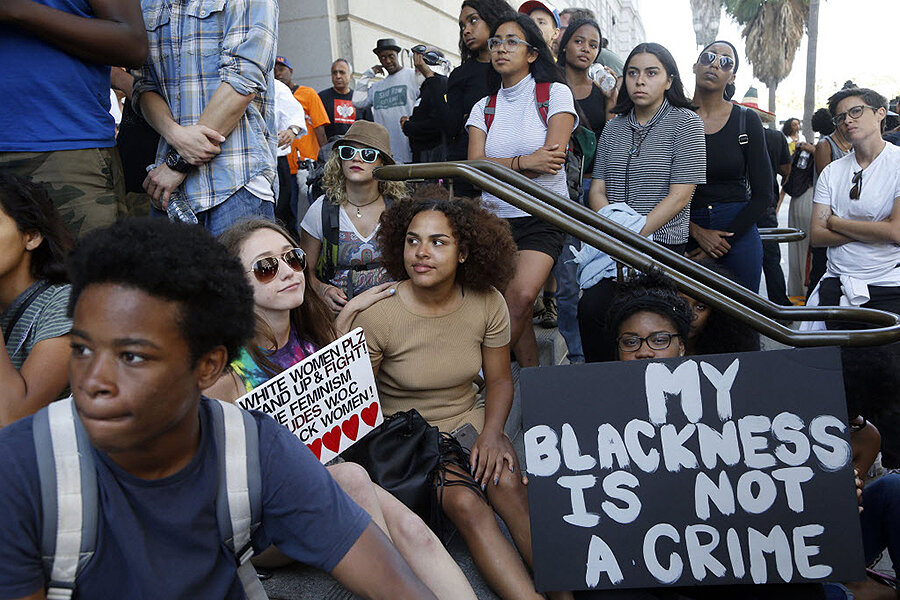Protestors march on city hall as LAPD fatal shooting is ruled justified
Loading...
Protestors in Los Angeles reacted with frustration yesterday to findings released by the police commission that the 2015 police shooting of Redel Jones, a 29-year-old black woman, was justified.
After the decision was announced, a group of about 100 community members marched to City Hall, where they pushed against the entrance doors as police inside kept them out. The group chanted “Fist up, fight back” and held signs that read “Stop Killing us” and “Justice for Redel Jones.”
Ms. Jones was fatally shot last August by LAPD officer Brett Ramirez, and her memory has been evoked throughout the past year by Los Angeles activists and community members, amid ongoing debates over police use of force throughout the country, the Los Angeles Times reported.
Police say that Jones matched the description of a robbery suspect who stole $80 from a nearby pharmacy and that she was shot after advancing on Mr. Ramirez with a knife, which she refused to drop. Another officer unsuccessfully attempted to use a Taser, according to the LA Times.
"I thought my life was in danger ... Only one of us was going to make it out of this," Ramirez said in a report released Tuesday, describing Jones charging at him with the knife.
A witness to the scene describes something different: Jones running away from officers, according to the LA Times.
Jones' husband Marcus Vaughn, who was among the demonstrators at City Hall yesterday, said he doesn't believe his wife had a knife.
"She was a beautiful, intelligent black woman who did not deserve any of this," he said.
Her death "has caused my children to feel like, you know, that I could someday get killed," Mr. Vaughn later told the Associated Press. "There's nothing that hurts worse."
The civilian review board's 3-0 decision that the shooting was justified comes in the midst of a tumultuous week for race relations and violence against and by police, after officers in Louisiana and Minnesota fatally shot two black men and peaceful protests in Dallas erupted in terror when a sniper opened fire, killing five officers.
Then on Monday in Baltimore, a judge dismissed one of several charges facing an officer involved in the death of Freddie Gray, who died of spinal injuries after being arrested and transported in a police van in April 2015. Mr. Gray's death quickly became another major touchstone for the Black Lives Matter movement and Americans concerned over police use of force.
Protests large and small have been on-going throughout the country in reaction to the latest high profile police shootings, as well as counter-protestors concerned over a seeming rise in violence against police.
The Bureau of Justice Statistics that there are between 928 and 1,242 law enforcement homicides a year, with 47 police officers charged with murder or manslaughter for on-duty deaths by gun between 2005 and 2014, The Christian Science Monitor reported.
Yet prosecution often has a tough hill to climb. For example, in 2015 there were more charges for fatal on-duty shootings than any other year in the past decade, but by September of last year, not one officer had been convicted of murder or manslaughter, The Wall Street Journal reports.
While journalism outlets and activists that independently track the numbers of Americans shot by police find that people of color are killed at higher rates than whites, a study released Monday by Harvard University researchers found no evidence of racial bias in situations where police fire their guns.
But statistics don't change the reality of the loss of life that has spurred outrage – and calls for change – throughout the country.
The White House has reacted by commissioning a task force to hear community and professional opinion and create a set of recommendations and reforms for the nation's police departments. Since that report was released in 2015, departments across the country have made steps toward building stronger community alliances and training officers based on the recommendations.
Reacting to the deaths of Philando Castile and Alton Sterling last week, President Obama has called for trust between community and police, saying in a Facebook post Thursday, "We can and must do better to institute the best practices that reduce the appearance or reality of racial bias in law enforcement."
Earlier this spring, the Los Angeles Police Department launched a plan to evaluate officers' use of force in an effort to emphasize “de-escalation,” the LA Times reported.
In an impassioned speech to the police commission before they made their decision, Jones’ husband Mr. Vaughn called on the LAPD to change their policies from “top to bottom.”
This report includes material from the Associated Press.







